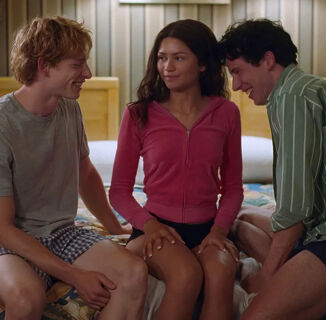New Orleans has always been a city that championed the arts and celebrated culture. This has led to a healthy gay social scene, drawing many LGBTQ artists and performers to the French Quarter. But the real reason folks flock to New Orleans, and in particular Bourbon Street, is for the parties. What started as a small house party in the Treme has grown to an infamous happening – Southern Decadence. The event draws more than 180,000 mostly LGBT partiers to New Orleans. Decadence is one of the city’s top five tourist events, right up there with Mardi Gras and Jazz Fest. But it’s not all just about Bourbon Street. New Orleans has so much to offer. Next time you’re in the Big Easy, take some time to enjoy the other offerings beyond Bourbon Street.
1. Area Plantations Back in the day when New Orleans was home to more millionaires than any other city in the country, back when cotton was king, the Antebellum plantations along River Road dominated. Today, they are now tourist attractions and they offer a glimpse into the city’s past.
Each plantation offers its own snapshot into the region’s agrarian history and most are within easy driving distance from New Orleans. Some of the plantations have restaurants and even overnight accommodations (for those who want the full historical experience, sans the actual manual labor).
2. Cemeteries The city of New Orleans is built below sea level, so you can only imagine that burying the dead became a problem for the earliest residents of the city. To overcome this topographical obstacle, residents began to entomb the departed in elaborate marble chambers above ground, which are now one of the city’s most lingering attractions. Wander the purported resting places of voodoo queen Marie Laveau, musician Al Hirt and Civil War general P.G.T. Beauregard, all residents of what is known in New Orleans as the Cities of the Dead. Many offer guided tours, others you can explore on your own…if you dare.
3. Museums Museums aren’t for everyone, but in a city filled with such a rich history and diverse culture, the museums offer an opportunity to learn the stories behind Mardi Gras, Indian costumes and culture, and immersion in the largest collection of Southern Art. Walk in the footsteps of America’s Greatest Generation at the world famous World War II Museum – in New Orleans, you’ll find endless places to explore and learn. Art, History, Family/Children’s, Historic Homes, Mardi Gras, Nature, Multicultural, Religious…there’s a bit of everything.
4. Historic Buildings & Homes Discover a portal into New Orleans history by touring the homes, drawing rooms, gardens and courtyards of some of the nation’s oldest original French, Spanish and American architecture. Whether you’re visiting a Creole cottage in the Treme or a grand plantation home, these homes are living memories of lives lived and lessons left behind.
5. Parks City parks in New Orleans are essentially extended backyards that offer entertaining places to picnic and barbeque, or just enjoy a lazy afternoon. All the parks are easily accessible by walking, streetcar or bike. The Spanish Plaza, dedicated by Spain in 1976 to the city in remembrance of their common historical past and as a pledge of fraternity in the future has a fountain surrounded by the seals of the provinces of Spain as its focal point, which also makes for a great meeting spot. Tucked behind Audubon Zoo across the Mississippi River levee, (known by locals as) “The Fly”, a waterfront portion of Audubon Park is a great spot to relax and take a breath from the hustle and bustle of New Orleans. Folks come out here to hang out, toss a Frisbee, have a crawfish boil, barbecue, or watch the sun go down over the river.
Palmer Park is a 5.6-acre park full of greenery located Uptown at the intersection of Claiborne Ave. & Carrollton Ave. The park is family friendly with a playground and monthly art fairs. It also is the home to many festivals, concerts and tours. Fulton Street is home to the 25,000-square-foot Fulton Square, an outdoor event space that plays host to block parties, concerts and special events. Woldenberg Park is great for biking, walking, jogging or just to sit back and relax next to the mighty Mississippi River.
6. Churches of Historical and Architectural Interest Historic places of worship, whatever their persuasion, tell stories of neighborhoods and the diverse population that has shaped the New Orleans we see today. Settled as a Catholic city, New Orleans is home to Cathedral-Basilica of St. Louis King of France, the oldest Catholic cathedral in continual use in the United States as well as St. Augustine Church in Treme, celebrating freedom from oppression. There are also Jewish synagogues, Islamic Mosques, Hindu shrines and small voodoo temples.
Where To Stay: NOPSI Hotel
Located in the heart of the Crescent City’s vibrant and convenient Central Business District, NOPSI is just two blocks from Canal Street and the bustling French Quarter. The guest room design presents refined furnishings and décor at the highest levels of luxury, all uniquely inspired by the building’s industrial history. Their restaurant, appropriately named “Public Service,” features a menu that honors the Gulf Coast’s hard-working fishermen and farmers. NOPSI Hotel also features a shimmering rooftop pool and bar, with an incredible city view.
DID YOU KNOW? LGBT rights were recognized by New Orleans City Council in 1991, with the passing of a gay non-discrimination ordinance. In 1997, Louisiana earned the distinction of being the first state in the Deep South to pass a hate crimes law that covered sexual orientation, and New Orleans Mayor Marc H. Morial extended domestic partner benefits to city employees. And, in 1998, New Orleans became one of the earliest cities to add gender identity to its list of groups protected from discrimination.
Image via Getty
Help make sure LGBTQ+ stories are being told...
We can't rely on mainstream media to tell our stories. That's why we don't lock our articles behind a paywall. Will you support our mission with a contribution today?
Cancel anytime · Proudly LGBTQ+ owned and operated
Read More in Culture
The Latest on INTO
Subscribe to get a twice-weekly dose of queer news, updates, and insights from the INTO team.
in Your Inbox













